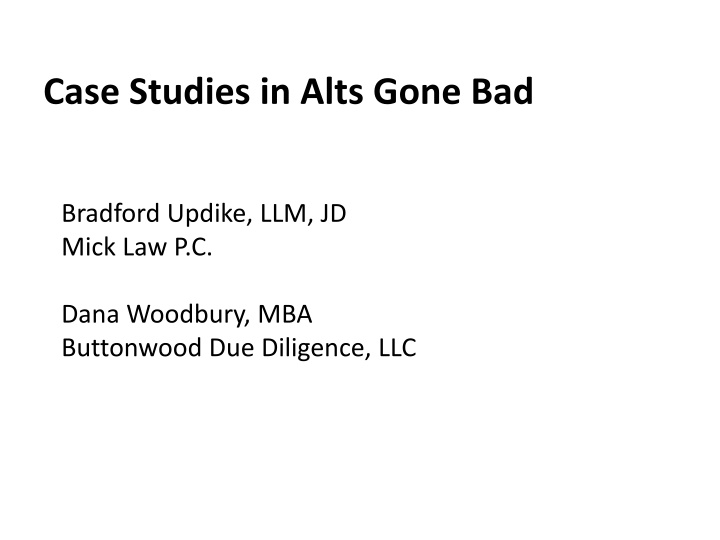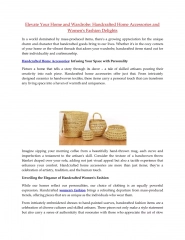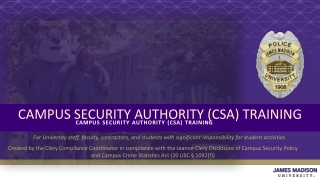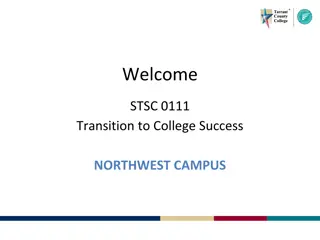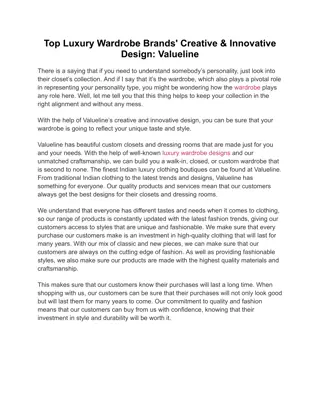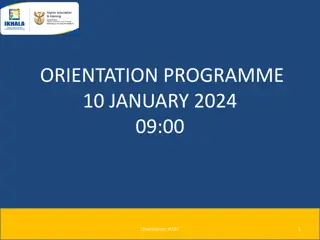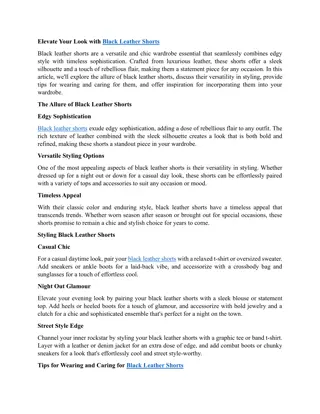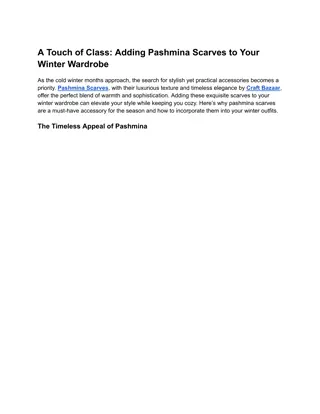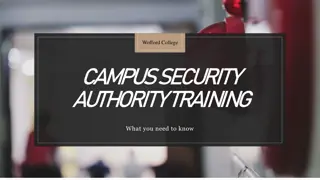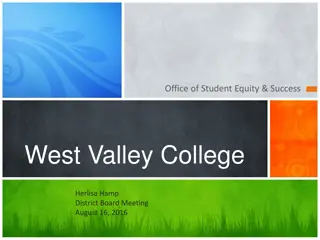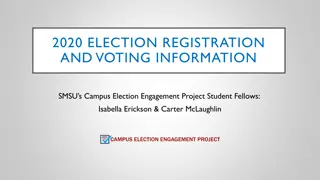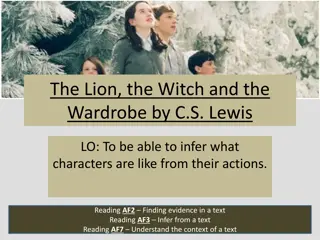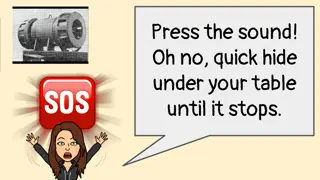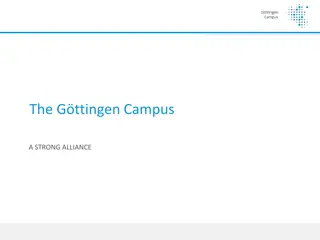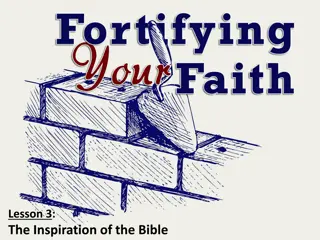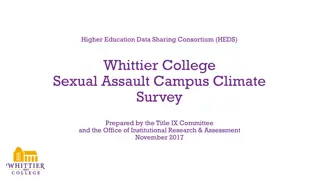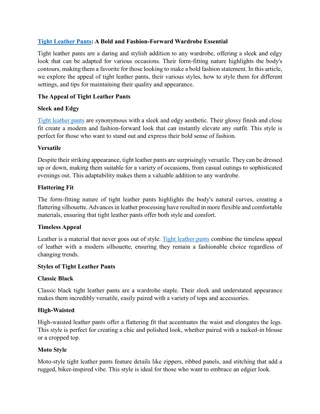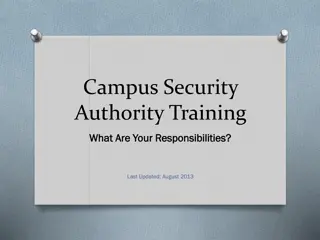Campus Wardrobe Inspiration for College Students
This project aims to guide indecisive college students with inspiration and practical tips for campus-friendly wardrobes. The research focuses on affordable and stylish pieces for female students at Claflin University, exploring fashion influences and user-friendly website development. Limitations include subjective definitions of appropriateness and limited representation of diverse perspectives.
Download Presentation

Please find below an Image/Link to download the presentation.
The content on the website is provided AS IS for your information and personal use only. It may not be sold, licensed, or shared on other websites without obtaining consent from the author.If you encounter any issues during the download, it is possible that the publisher has removed the file from their server.
You are allowed to download the files provided on this website for personal or commercial use, subject to the condition that they are used lawfully. All files are the property of their respective owners.
The content on the website is provided AS IS for your information and personal use only. It may not be sold, licensed, or shared on other websites without obtaining consent from the author.
E N D
Presentation Transcript
Case Studies in Alts Gone Bad Bradford Updike, LLM, JD Mick Law P.C. Dana Woodbury, MBA Buttonwood Due Diligence, LLC
Appreciation to members of ADISA Product Quality Task Force Sherri Cooke, AI Insight Bradford Updike, Mick Law Travis Hicks, Independent Financial Group Greg Mausz, Preferred Capital Securities Jean Merriman, Strategic Financial Alliance Michael Miller, Sigma Financial Ann Moore, International Assets Advisory Lilian Morvay, IBDC Consulting
Why are we here today? Not to lay blame or point fingers we ve all faced challenges FINRA/SEC Madoff Our industry perhaps the infamous three Time for reflection let s talk about misconduct, why perhaps it occurs from time to time, and how we can arguably better manage the risk of it Discuss best practices for vetting misconduct
Our ultimate goal select products that work So why do some sponsors perform well? Strong market fundamentals (usually) Executive know-how (usually) Financially viable sponsor (almost always) Structure/skin in game (i.e., who s putting money in, who s taking money out, and is the sponsor comp performance based) Accountability (e.g., financial transparency, strong accounting controls) (usually)
And some deals dont work why? Bad markets (25%) A calculated decision produces a bad outcome (50%) Too much debt Wrong drilling methods used We developed the project in the wrong city We were off budget Bad structure sponsor got paid too much (20%) Misconduct (5% or less, which often occurs after BD does its initial due diligence on the first deal or two)
What reason for program failure gives regulators and the press the most heartburn???? Fraud & Misconduct It s your job to stop it (or is it?) General regulator attitude post-Madoff So that s why we re going to discuss it
Faces of Misconduct Improper use of funds (in order of importance) How are distributions paid? Improper use of funds in affiliate transactions Fund A sells to Fund B Fund A loans to Fund B Outright misappropriations Culture of accountability can help prevent Undisclosed sponsor mark-up and profit Sponsor buys asset and sells it to Fund A What did the sponsor pay and what value was added? Is the asset seller a sponsor affiliate/adviser? Is this ever justified? What value was added? Independent U/W needed at minimum Mark-ups on drilling and construction cap. ex. PPM pitfalls Is the sponsor financially viable? Will sponsor go out of business if the max. is not raised? Is the sponsor s performance record fudged (e.g., retail vs. non-retail)? Is the sponsor manager s past bad conduct reflected? Risks underneath the boilerplate THIS SPONSOR - what are the specific risks? Due diligence should be designed to catch all the above
Q & A Session Is it easy to identify sponsors/programs that present high misconduct risk? Why not? Misuse of funds What leads up to it? (Black Swans, weak accounting, too much manager discretion) Hidden sponsor comp How do we find it? Are affiliate sales easy to spot? PPM mishaps (revisit last slide) Marketing materials what can we tell about a sponsor through the tone of the marketing materials? FINRA Rule 2210
CASE #1 Royalty Funds 1-22 Late 2000 s Energy Focus: Minerals & Royalties Structure: Corp. issuer selling preferred shares w/mo. dividend and anticipated 2-3 year hold (i.e., income oriented product) Sponsor was formed 2 years before it entered the retail channel (a couple advisors had some mineral buying experience) Sponsor buys minerals ahead of drilling (no yield until operators on the properties drill, it s similar to buying commercial land)
Case #1 All Good Year One 2007: The income product appeal generates BD interest First five programs in 2007 raise $100 mm and buy assets in a promising play The programs buy good assets & a major company agrees to partner up A major energy lender extends $150 million LOC to the sponsor Sponsor grows its business from a handful of employees in 2006 to 60 employees YE 2007 Sponsor hires a proven outside land team to position the assets for a major divestiture (the team has won big before) Things look pretty good at YE 2007 as natural gas prices keep moving higher
Year 2 2008: The retail money flows because the programs are marketed as income products (and because the sponsor did what it said in 2007) But there is a lack of a disciplined business culture Org docs and bank LOC allow payments of dividends with investor capital and loan advances (it s unquestionably allowed at an inter-fund level) Affiliate transactions are allowed (Fund A can sell to Fund B and so forth) 2008 Programs can buy minerals, royalties, and overrides anywhere 2007 Programs pay dividends to investors (Q: IS IT WRONG?) But not enough revenue is there to cover dividends (sound familiar???) Sponsor uses its credit line to buy more non-yield assets (i.e., leases) Accounting system is weak let s figure it out later
Case #1 Where Did it Fall Apart? Black Swan Here We can t miss Oh Really? Sponsor underestimated its competition (CHK sells its minerals to BP for $2 billion) Natural gas market drops during late 2008: August: $7 mcf Sept: $6 mcf Oct: $5 mcf Nov: $4 mcf Didn t use capital to drill or buy production, so earnings can t cover dividends Panic sets in: Sponsor uses investor funds to pay dividends & buy time (Oct. 2008) (Q: WHY IS IT WRONG? A:IT S INTRA-COMPANY AND THE SPONSOR S BUSINESS IS DEPENDENT ON IT)
Case #1 Noise Sponsor did what it said in 2007 Sponsor has major partner & looks like it will execute (Dec. 2007/Jan. 2008) The bank gave sponsor $150 MM why would a bank lend if it s not viable?
Case #1 - Lessons Ongoing due diligence (review all 22 deals) Sponsor capitalization must it raise capital to survive? Does the whole sponsor conglomeration depend upon this offering? Require accounting discipline early Can t pay a yield on a non-yielding asset Does the business culture cultivate misconduct? Affiliate transactions? Dividend sources? Acquisition policy too broadly stated? Financials/reporting?
Case #2 Structured Finance Sponsor buys receivables from businesses at a discount and makes secured loans backed by receivables (Funds 1 & 2) This sponsor was in business 10 years before entering the BD channel Keys to success: the purchase discount drives the profit Investors put money in a series of programs that buy receivables/loans from the sponsor Investor notes are secured by a program s assets 3 Year 9.75%, 5 Year 10%, 7 Year 10.25% The assets are not sold at cost sponsor sells assets at cost plus a high percentage of the unrealized discount (i.e., sponsor is taking the upside and passing collection risk to the investors) Sponsor raises money over six programs 2003-2009 Not a good structure but AGAIN the demand for this income product is huge
Case #2 Seemingly Positive Beginning 2003 Fund raises $250 million and acquires assets (i.e., $775 mm purchases and $900 mm collections) 99.9% of 2003 Fund s investors were paid principal and interest Receiver s report indicates a presence of significant investment activities, with the 2003 Fund being generally profitable Arguable proof of concept in Fund 1 ignites a pattern of substantial fundraising (more to come)
Case #2 What Went Wrong $2 billion raised, but 50% was really used to buy assets (excluding affiliate purchases) No audits at any level (sponsor, programs, collateral coverage, sponsor had reviewed financials by a local firm in 2006) Lack of accountability to a noteholder representative Significant change in business strategy with Fund 3 (added private equity and mortgage lending) Programs can buy assets from other programs (shell game move assets from Fund A to fund B) Program s capital can be used to pay interest to investors of any program System of non-accountability cultivated fraud Even 2003 Fund had some affiliate sales/purchases (not as many as the later funds)
End Result The House of Cards takes 7 years to fall apart (note that Fund 1 generally started ok) $2 bill. raised but about $1 bill. spent on assets $300 million transactional losses $500 mm uncollectible receivables A lot of aged receivables were purchased and/or transferred fund to fund Meaningful ongoing due diligence Investor payments = earnings???
Cases #3-4 Real Estate Sponsors Sponsor A Very Established In business 30+ years 75 sponsored real estate offerings - $600 mm equity (with full cycle deals at 30% IRR) 100+ employees Sponsor B An Upstart W/Promise Prior to being retail, 10+ transactions with 20% IRR (small deals though) Short time in business but was off to a decent start in real estate Has an established following in the professional sports arena and several NFL players are employees and/or investors (trendy) Sponsor has an affiliate that is a state registered RIA (someone s watching the sponsor right?) Track records here and proof of concept - What s not to like?
Cases #3-4 Activities Outside the Retail Circle Both had businesses outside of the BD circle The businesses were not complements of the retail business (real estate vs. technology/insurance) Sponsor s resources to effectively account/manage was, in fact, lacking Lack of personnel on the non-real estate side Accounting system lacked controls (Sponsor can do what it wants - no outside financial review)
Business Culture Cultivates Misconduct Lack of financial accountability - both Affiliate transactional ability upstart Open-ended investment authority (upstart can buy anything) Undisciplined business practices Established sponsor non-securitized 1031 platform outside retail channel Up-start leverages its professionals to promote the business
End Result Accountability lacking Money raised in retail channel diverted Activities outside of the retail channel derailed the retail business
Best Practices Can We De-risk? Economic structure fits assets? Management authority controlled (e.g., leverage, how they buy/sell assets) Financial transparency is a must Management should be paid to perform Distributions should almost always be paid with earnings Disciplined program environment make the manager accountable! Ongoing due diligence (e.g., Funds 1-22 & sponsor financials) No need to self-deal/sell assets within affiliate programs They put real money in and get paid to perform No need to engage in clever marketing Real time program performance/accounting data Don t tell me a story show me the numbers What do the performing sponsors do?
